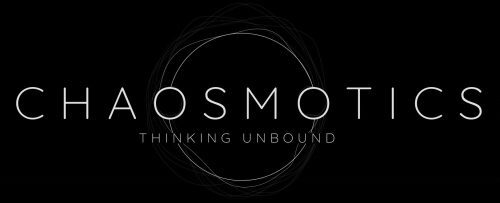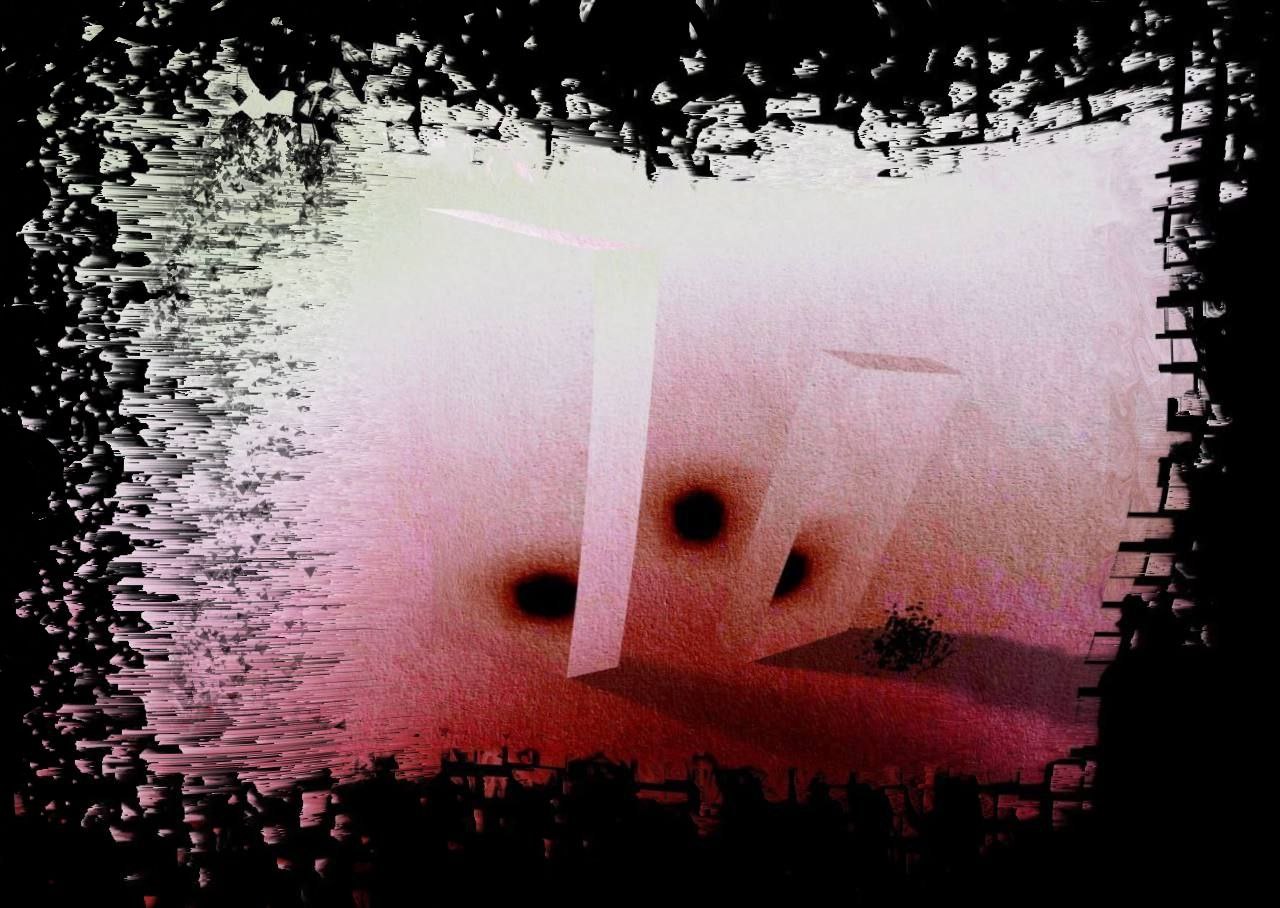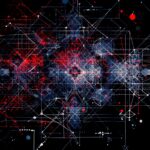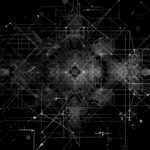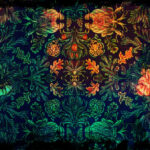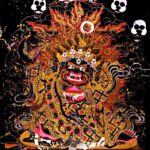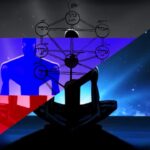Here for part I
At the still point of the turning world. Neither flesh nor fleshless;
Neither from nor towards; at the still point, there the dance is,
But neither arrest nor movement. And do not call it fixity,
Where past and future are gathered.
…
Only through time
time is conquered
– T. S. Eliot, Four Quartets1
In a key passage in The Elementary Forms of Religious Life, Durkheim explains how the sacred, in all its forms, represents a mode of self-celebration of society itself. The object of veneration is the social order. From a certain point of view, Girard would agree: society is what saves us from original violence, from ancestral guilt. Although every ritual and every mythology tells of that origin, and likewise attempts to keep it separate from the present, the social order is the horizon in which a world is preserved. Society is the appearance of man, his separation from everything else; it is a technology that manifests the human as a subject, even if this garb of his is always threatened. Rituals renew the separation, while myths recount it, holding it fixed in time, and above it. If we did not remember the origin, and if we did not repeat ad infinitum the first purification, we would risk losing the cosmos; the cosmos was, without reluctance, the greatest chaos. Memory, thus, is the fundamental element for society and its sacredness. But not memory of the “truth” of facts, of things, of origins manifested and illuminated by knowledge. Memory is of separation – and of passage; not happening, but continuum. Remembering to have never remembered.
Apollo is Artemis’ twin. When Pausanias lets Erophile, the sibyl of Apollo’s sanctuary at Delphi, speak, he makes her say under the influence of Artemis: I am Apollo’s wife, sister, and daughter 2. Of Artemis she was said to be virgin and pure (hagné), untouchable – apart from her brother, and father, and husband, god of the sun, intellect and the arts. The wildest of deities, mistress of animals and the hunt, was born from the same womb and on the same day as the one who represented what would, in the future, erase “nature” by sanctioning its separation from “culture”. Apollo and Artemis are a Rebis, the sacred union of opposites, the complete androgyne. Both are infallible archers – they kill without touching. Calasso sees: the character of Artemis, hagnós, “implies a detachment. It is reverence before the unknown. The quality corresponding to hagnós is called hagneìa: without it no cultural act can be effective” 3. According to Kuhn, the only possible scientific progress is an “increase in solutions to the enigmas posed by a given paradigm”4. No phenomenon can ever be grasped in its essence, since every worldview is condemned to be an insufficient representation of the totality. But then, renewing the oracular care in the choice of words, he adds: our research and our practices are determined by the resistance that the world offers to our attempts to read it5. Artemis does not speak, and Apollo does by enigmas. In the beginning was resistance – but the beginning is only a passage.
Hesiod’s Theogony is a mythological poem that, Burkert6 and Cornford7 acknowledge, gathers influences from a geographical area ranging from Mesopotamia to Egypt, from the mountainous spaces north of Colchis to the forests of Thrace. Hesiod narrates the origin of the world, from primordial Chaos to Zeus king, attempting to bring order to what was, at that time and for them, the whole world. It is in Works and Days, on the other hand, that Hesiod tells of the ages of man, of what Calasso calls the tale of the great and dramatic detachment of anthropos from the rest of the zôion, the living beings: the absolute separation, the beginning of the ages and times. This “fall” of man is narrated in two versions: the first is the famous myth of Prometheus, while the second, “which Hesiod calls lógos”8, is a slow and very long fall, anything but linear. From the Golden Age, a time of maximum splendour and prosperity, to the Iron Age, the time of Hesiod, the years heralding the classical age – the age of the poleis, and of the Peloponnesian World War. Passing through the Silver and Bronze Ages, and the Age of Heroes. The latter, just before the Iron Age, lasts no more than three generations. Its protagonists, children of gods and men, beings somewhere between zoè and bios, represent a large set of interconnected stories that end with the story of Telegonus9. Calasso recognises in the Age of Heroes a moment of unparalleled magnificence of myth: every event and happening, every place and instant, were collected in the single tales that were linked, in an almost obsessive manner, to one another. This is not, however, exclusive to that age, which rather represents the beginning of fragmentation. “The Hesiodic succession of world ages has Indian, Iranian, Mesopotamian, and Hebrew parallels”10; the world is the parchment on which the world’s tale is written.
Göbekli Tepe’s fame has been growing over the years, ever since carbon dating indicated its unexpected antiquity. About twelve thousand years ago, not far from the Sumerian city of Uruk, a population of hunter-gatherers erected a kind of sanctuary, consisting of stone pillars arranged in a circle, each bearing high reliefs or carvings of animal figures11. The 12th and 11th millennia were not the time of farming; the beings represented at Göbekli Tepe were still direct contenders for space on earth. The latter could be killed, or they could kill. The ones on the pillars was also a story, and it was also a set of recognisable faces: a classification. It was a memory of other beings, who were “other” in a much less severe way than they were millennia later. Göbekli Tepe was then buried voluntarily, and abandoned; memories of when time was also of animals. Mesopotamia began to experience the universe that is the city; that other history, perhaps, was no longer needed.
***
The term cosmogram is used by Tresch to offer a general concept through which to think about all the complex and multiple forms that humans have developed, throughout history, to “materialise” their interpretations of the world, cosmologies12. Examples of this can be objects of any type and kind, such as the Bible, a ritual, the structure of a city, a painting, a temple; each of these objects, for Tresch, is the concretisation of a particular cosmology, the materialisation of a performative worldview insofar as it is capable of communicating and passing on information to those who are part of a certain community13. These objects are, therefore, symbols, catalysts of information. A particularly relevant example of this is the temple: it is modelled on divine instructions (as in the case of the Tabernacle in Exodus) and celestial and cosmological correspondences, and thus has the task of representing the image of the world. In the cosmogram, the cosmos is embodied; matter is modelled in such a way that it conveys not so much a meaning, which is already deferred, but the cosmos itself. A part is separated from matter to describe the indivisibility of the whole. In order to avoid having to admit that every artifact is a cosmogram, as a manifestation of the individual’s operation and his experience of the world, Tresch emphasises how it must take on a social value14. That is, one can call a cosmogram that object which expresses an interpretation of the world shared by several individuals and which makes epoch or community or produces meaning.
The real difference between cultures and between narratives would therefore be most clearly and distinctly manifested through cosmograms. Each of these signs does not exhaust its performativity in the affirmation of an imago mundi based on consensus, but triggers processes of critique and reinterpretation, ultimately also acting as a fulcrum of dissent and change. Every cosmogram, however powerful it may be, is destined to multiply itself in different forms, structuring a network of signs that together compose the grammar of universal history – the one that Yuk Hui, for example, wishes to rewrite on the basis of cosmotechnics. When in 1979 Lyotard describes the postmodern condition as the moment of dissolution of the great truth narratives, he is not only talking about the progressive loss of meaning of individual historical cosmograms, such as the Bible, Capital, or Delacroix’s Liberty leading the People. The collapse of the great narratives more properly indicates the diminishing capacity of cosmograms to produce reticulations, to differ in possible reinterpretations and reinscriptions: to produce, therefore, the different and the new. This is what Fisher discusses in Capitalist Realism:
The new defines itself as a response to what is already established; at the same time, what is already established must reconfigure itself in response to the new. According to Eliot, the exhaustion of the future also leaves us without a past: when tradition stops being contested and modified, it stops making sense. A culture that limits itself to preserving itself is not a culture15.
Such is the result achieved by the utopia realised by Western modernity, in the two faces of the end-of-history (Fukuyama) and postmodernism (Jameson). Time breaks down, the mechanism of the cosmic clock stops; life goes on, but the hands do not run. Time is out of joint(nota sull’amleto), writes Derrida in the exergue to his Spectres of Marx: time has gone off its hinges. Cosmograms become part of the incessant noise of communication, and the universe of signs without a referent, the simulacra. Hyperreality and the disappearance of time: the possible title of a Hollywood product. The partially missing real from which the cosmograms and their paradigms originate is replaced by its representation: the image of a completeness to be revealed, or unveiled. With no more background to cling to, the figures levitate and disperse. The collapse of time upon itself – its fulfillment – also results in a collapse of space. A cosmos thickens, and in such density the production of cosmograms is neutralised. The main mode of relating to cosmologies is nostalgic, revival, as Jameson states; they are disconnected from each other, out of time – literally, and musically. Retrievals without affirmation and without context, with the sole purpose of filling the void of the rupture of time. In this sense, Tresch’s cosmograms become part of that universe of spectres that a) are not (any longer) concretely present, yet continue to insist on the present as virtuality, and b) extend, from the past, towards a future that they inhabit as attractors, as old projections of possible worlds16. The science of cosmograms that Tresch hopes to delineate is already a science of corpses, or of their sighs in the rooms of their ancient abodes. But if, to understand the images of the cosmos, the present-specific going native is necessary, Tresch admits, it remains for us to investigate the dialogue, the conflict, the fusion, the substitution, the alliance between cosmograms. Of these objects – of these wrappings of ghosts – all we are left with are the passages: all we are left with is to observe the spectres abandon their flesh.
***
The Birth of Tragedy has existed in at least three forms. The first is that which conceives the text as a by-product of Schopenhauer’s metaphysics, thus in clear contrast to the positions of the late anti-metaphysical Nietzsche17. The second birth, which opposes the first, is the one whereby Nietzsche uses that metaphysics as if it were a myth, a good redemptive illusion18, and functional to the creation of a new tragic civilisation. There is no truth in that metaphysics, but a strategy of the good life; one believes, while recognising no reality in it. Nietzsche uses that metaphysics, and the productive power of narrative. One wonders, however: from what is reality to be redeemed that is replaced by the “good illusion” of myth? From its feigned purity – which has produced, and nurtured, the unexpected guest. Nietzsche plays with dissonance too.
The recovery of the metaphysics at work in Attic tragedy results from a preliminary difficulty. Nietzsche knows well – he learnt from reading the Greeks – that nothing is more threatening than passing. One does not leave a house without the existence of its very inhabitants being at risk of dissolving. The fall of any image of the world cannot mean a fall into nothingness: other shelters must be offered. The game of substitution is repeated – the game Lyotard looks upon with contempt19 – but Nietzsche already senses that in it the demon of immobility waits patiently. The new image cannot assume the role of the old, it cannot define itself as Truth – but in it, despite everything, one must believe. In the value of belief, the stakes are defined: can one trust in something that has no universal claims? Doesn’t a metaphysics such as the tragic one, expounded in such a way that it appears as a remedy for the indigestion of illusions, define itself as a new universalisation of a particular worldview? Not a truth, but an instrument of life affirmation. Nietzsche shows that he believes, and expresses himself for those who are akin to him, the “initiated”20. Later, he will abandon his belief in good illusions: affirming life will become an individual path, and no longer a collective one21. Some have tried to prove that Nietzsche really believed in the theory of eternal return22. But theory does not create, it suspends; the eternal return will only be a strategy, an attempt to short-circuit thought. Not an illusion of truth, but a possibility from which all escape is precluded. A specter: “a virtuality whose threat of realisation was already in the act of compromising the current state of affairs”23.
At a certain level, tragic metaphysics – neither lost in immediate intuition nor in the illusion of universal truths – is the juncture between Laurelle’s greater Hermes (the god of truth and its communicability) and lesser Hermes (the god of the real-as-secret)24. The relationship between the secret and the subject is always unidirectional, Laruelle asserts; all philosophy – and indeed all cosmology – results as a device of interaction with the real-as-secret, the opaque real, the original amorphous from which forms are extracted. The healing character of tragedy and its metaphysics is only effective if each person structures his myth from the experience of the secret. The third birth is the rhizome.
Greek myths are many and ridiculous, writes Hecataeus of Miletus in the proem to his Genealogies25. It is necessary, for us who want to remember and understand them when we tell them, that things resemble reality, what our eyes see and our ears hear. The mind and the world must conform, or everything is just convention, and then everything can be said. That is: we must find a way of remembering things that transcends time and space. Hecataeus was the first manifestation of a transition, a metamorphosis that may seem like a trifle compared to what happened in Göbekli Tepe. The zither and the voice of the aedo, the embodiment of storytelling and memory – Homer is one and many: he is the collective memory, and a cosmogram – are replaced by the parchment of the historiographer and the geographer, who resent the oracular and symbolic language. Thucydides does not write to delight – unlike Herodotus. Worlds replace one another; cosmograms collide. A passage of such depth and complexity culminates in a way that is tremendously similar to the Niccian tumult; Plato extracts the most pulsating roots of Greekness, the myths, from the earth and turns them into an órganon, a tool that accompanies the argument, that explains or covers up. Myth, for the first time, becomes metaphor. The myth, which had been the world, becomes its analogon. In the Epinomides, which is believed to be the last book of The Laws, Plato spends few but crucial words on the discovery of the incommensurables. The stakes are immense, as immense was the wrath of the gods “with the disseminators of the doctrines of Pythagoras”26 on irrational magnitudes: the gap, approximate but irreconcilable, between the mind and the world.
What Plato did, however, was not an act of domestication of the untamed. On the contrary, he sought to keep the divine, and with it the sacred, outside the social order; implicit in it – the social order is a making-order among the necessities of the world – but external. There were two Greek words for necessity, notes Calasso: ananke, the absolutely necessary that precedes even the divine, and týchē, the inevitable happening, fate or destiny, which is a more disordered and fluctuating type of necessity27. Ruling human affairs are a god, and then fate (týchē), chance (kairós), and téchnē. In the occasion, inevitability manifests itself, which man can follow, indulge in, through his mastery, his art. Plato had all this affirmed by the Athenian, the main dialogist of The Laws, in a final anti-nihilistic gasp. Far removed from the expressive and stylistic force of the early dialogues28, Plato found himself mounting the last defences against a world that had begun to abandon the divine (before him) and would continue to abandon it – to relegate it to the social order, as its organ. But without a foundation, society would be resting on nothing – and would forget itself. That is why Plato’s reflection is in the first instance a politeia.
“A disruptive novelty introduced by the Sophists in Athens was the conception of nomos as a convention. Hence as something foreign to physis and independent of it”29. Téchnē lost its connotation as the art of understanding the resistances of the world, and opened up to creation. Man creates the order of (his) world, a horizontality that is renewed and affirmed by Aristotelianism. Plato, between two fires, emerges from the danger of an abyssal void – the tyranny of freedom and creation – in the transition between the world traversed by and intertwined with the sacred, traversed by memories and the invisible, and the world dominated by the sacred, in which an emancipatory counter-movement was thus produced. “Oh strangers, is it a god or someone among men who was at the origin of the institution of laws?”30; this was the ultimate Platonic question, as much as it was the first. When Plato coined the concept of theatrokratìa, the “government of the spectacle”, he looked carefully at the evolution of the theater spectator. No longer an individual lost in silent and mimetic contemplation of the stream of meanings and perceptions flowing before him, but a tractable character, “talkative instead of mute he was, and convinced that he knew how to discern the ugly and the beautiful”31. If the wisdom granted by the god was also the acknowledgement of human limits in discerning the things of the world – Socrates could only recover this posture against the sophists –, what was asserting itself before Plato’s eyes was an excess of freedom, the abandonment of a cautious approach in the presence of the ineffable and its sacredness. And the spectator, thus, spoke and acted, chatted and sentenced, strong in an unfounded confidence – so much so that the audience became the heart of a form of politeia placed alongside monarchy and democracy. Theatrocracy, the realm of doxa; the divine was not rejected, but assimilated into familiarity. More than two millenia later, Debord did not invent anything.
What did it mean to save the divine? Repairing time. The divine was the dimension in which becoming was safeguarded – the possibility of indulging the fate that appeared in the rifts of time. Plato’s use of myth was, therefore, not an act of domination, but of reverence. Not merely belief, but the production of belief. Plato observed the vault of the cave as one observes the vault of the sky, the place where stories were told (the constellations and cave paintings), where the world can quieten down. But quiet is not: the Athenian in The Laws recognised that the workable form of the just society was only second best possible. That is, the ideal was obliged to yield to the resistances of the real. Far from implying that ideality is useless, Plato emanates a specter. Fine hauntological strategy: demons that insinuate recurring thoughts, obsessions – the greatest burdens. How much of Plato was in Nietzsche? How much of the hunters of Göbekli Tepe in Plato? How much of the beings of the pre (-history, -humanity, -world, -socius) in the hunters? The chain of questions, then, can run backwards. Memories of many passages, and the secret of their occurrence.
***
Never has man come so close to experiencing the meaning of eternity as in this age of fragmentation. In it, its totalising and claustrophobic character. Eternity is the narrowest of the rooms of time. The largest is infinity, attested by the intricate, senseless, and immense city on the edge of which Borges’ immortals dwell. In infinity, Marcus Flaminius Rufus traverses history and chooses the right moment to die. In eternity, birth and death are the same instant. “As outlined in the thinking of the social democrats,”32 says Benjamin, progress was articulated in three instances. Human progress, without any particular determinations; progress without end, i.e. the perennial journey towards perfectibility that is never completed; unceasing progress, which defines a path of time as a line. Benjamin’s image of this concept is the catastrophe: “let everything continue as such”33. And he juxtaposes it with the Niccian eternal return in a further new guise. Not a strategy nor a threat to the immobility of thought, but a historically determined expression of happiness – of the good life. “The eternal return is an attempt to bind together the two antinomian principles of happiness: that of eternity and that of ‘once again'”34. Any attempt to repeat is a threat to immobility. If Fisher’s messianic charge resided in the reappropriation of time, it encompassed the entirety of temporal dimensions: of the past, the abode of specters, of the future, the range of possibilities, and of the present, the crossroads of currents. In catastrophe, one must look for the small leaps where eternity comes to a silent halt. “One must study in depth the question to what extent the extremes to be understood in salvation are ‘too soon’ and ‘too late'”35; much of the contemporary collective imagination drowns in the simulacra of small and large apocalypses. Recurring symptoms of the disease of time.
“Only in the image […] can the past be fixed”36, Benjamin confidently states in the sixth of his theses on the philosophy of history. A fundamental addition to one of the previous theses, the second, as fine and sharp as a sheet of paper in the hands of the hasty: the totality of the past – of the images of the past – is the jewel brought as a dowry to a redeemed humanity. “There is a secret understanding between past generations and ours”37 – secret to everyone, even to the poles of that very understanding. Only for redeemed humanity is the past citable in each of its aspects; of nothing is one terrified, of no image, of no word. This is the meaning of historical materialism, of history as the grand narrative of the class struggle. Before time, this history is meaning, and therefore decision. It cannot help but appear, however, the question of the passage of time, and what passes in it. The struggle, too, is the substitution of figures – even if only two, the dominant and the dominated, and their final sublimation. Between the figures lie the suspended instants – the “little leaps into eternity” – like revolutions. Which are never what they promise; Lyotard is categorical about the illusion of reinscription. We are only reiterating, again and again, feeding eternity. What is the time after the end of time? There is no redemption in Lyotard, only testimony. Benjamin quotes Hegel: “seek first food and clothing; and the kingdom of God will come to you alone”38. Spirits can only emerge in corpore sano.
In his immanentist reading of Hegel, Stephen Houlgate indicates the concept of virtuality as one of the main differences between the Stuttgart philosopher and Gilles Deleuze. For Deleuze, the virtual and the actual are both real: the virtual is not simply the possible. Hegel recognises the existence of something that is neither actual, nor necessary, nor simply possible; there is a difference between the formally possible and the concretely possible, where this second form of possibility represents a situation that contains within itself the actual conditions of something that has not yet manifested itself, and is therefore only virtually actual. These conditions will manifest themselves, yet they still remain enclosed within themselves. For Hegel, these forms of possibility do not have a different structure than formal possibilities: they cannot be called quasi-transcendental conditions. The problem with the virtual, Houlgate argues, lies in the fact that it seems to simply take the place of the transcendental. The virtual, as a generative background, never manifests itself as such, whereas for Hegel there is nothing that does not manifest itself: nothing ultimately remains hidden. Even when something attempts to remain hidden, it appears through such concealment. Time is therefore the place of the extrinsicisation of all that is possible. Deleuze writes: “Bergson constantly reminds us that the All is not given. And this does not mean that the idea of the whole is meaningless, but that it designates a virtuality insofar as the actual parts do not allow themselves to be totalised”39. In the small realm of thought, nothing is hidden.
To know everything: to arrive, in time, at the full appropriation of every object of knowledge, which is also every object of the world and the world as object, in which time itself is but a concession, a gift. It is thanks to time that knowledge exists: Apollo and Dionysus are grandchildren of Chronos. Laruelle would define this vain hope as the essence of the device of Hermetological Difference, the indissoluble correlation between truth and its communicability. The Hegelian assumption of nothingness is hidden would be irreconcilable with the narrowness of philosophy, from Laruelle’s point of view, who describes the philosophical device as one téchnē among others, a piece of machinery that offers partial images extracted from an opaque and obscure background. In Laruelle’s non-philosophy, there is no philosophical knowledge that is not always the result of a preliminary decision, and a methodology, that will irremediably end up hiding something in favour of something else – and concealing the fact that the real itself is given in essence as a secret. Hegel never refers to total knowledge. Instead, the absolute knowledge of the spirit is, from the very etymology of the word, ab-solutus, a knowledge loosened from the finite, in continuous becoming and perpetual evolution, without prior conditions of possibility. Nor premises, as he emphasises forcefully in the introduction to The Science of Logic. Posture in the face of the impossibility of grasping everything at a single moment; nothing is absolutely hidden, everything is at a time. Laruelle uses the mythological figure of Hermes, and myth itself as a vehicle of manifestation, to enact his analysis of the limits of philosophy. Hegel, in the Phenomenology, tells the long story of consciousness and its concealment-disguise-recognition through figures that are impossible to circumscribe without them slipping out of hand as soon as one thinks one is holding on to them. Laruelle’s lesser Hermes does not unveil secrets, but presents them – just as the history of consciousness is presented in the Phenomenology without anything in it being graspable until the realization of the spirit, when the secret, on the other hand, seems to unveil itself. It is in the rationality, and thus maximum communicability, of the real that Laruelle sees the Hegelian error: the real-as-secret is incommunicable and intangible. Hegel would reply: nothing is absolutely hidden, not even the secret – even in extreme silence, it presents itself. It is good to hope that, in the history of philosophy as a history of hesitant larvae40, Laruelle is not a butterfly.
In his famous 1894 lecture The Four Phases of Philosophy and its Current State, Franz Brentano describes philosophy as a discipline with a twofold nature. On the one hand, it seems to follow the path of the sciences, in a constant and positive progress; on the other hand, something of philosophy is twinned with art, and with its proceeding in twists and turns, collapses and rebirths. Brentano offers an impossible image, between Apollo, Dionysus, and the wisdom of which they are bearers. How does philosophy’s time flow? It inhabits a cocoon, an extreme manifestation of eternity, in which each of the great and small figures that articulate the path continues to discuss with the others, in a single crystal of time – beyond millennia and oceans. But still, what does this immortal, and always almost dead, and always just born device eternally discuss? “When the power of unity fades from the life of men and the antitheses lose their living relations and reciprocity, and become independent, there emerges the need for philosophy”41. In the death of something, unity – the desire for a unity that is lost and is given as lost, the death of meaning and the disjunction of this from the world – thought is activated. It is not a question of the origin, of the when of this death, but about what death is a sign of. Mourning must be processed, it takes time, it follows the disappearance, it fills the void – if it can – of what has disappeared. Philosophy does not then emerge in death, but in mourning; it does not witness the dying, but observes the corpse, stands before it. The happening is already accomplished, when the need for unity emerges. Death is the sign of every passage – and it is only in the passage that continuity can emerge. Along with time. In the loss of unity, in the midst of figures and before an elusive opacity, the horizon preliminary to every hermetological decision emerges. Lyotard calls it judgement; it is the horizon of the inhuman.
***
A crisis forces us to return to the questions; it demands new or old answers from us, […] and it only turns into a catastrophe when we try to handle it with preconceived judgements, thus exacerbating the crisis, and giving up that experience of reality […] that the crisis itself constitutes.42
With these words, collected in the 1961 volume Between Past and Future, Hannah Arendt discusses the crisis of education in the United States in those years. Her use of the term “catastrophe” appears to be opposite to Benjamin’s, and more related to the etymology and essence of the word: katastrophḗ is a geometric reversal. But what is it that risks being overturned in a crisis? The field in which the question of the crisis of schooling in those years unfolds is, for Arendt, the relationship between the time handed down by educators, and the time inhabited by pupils. “Educators represent before young people a world for which they must declare themselves responsible even if they have not made it their own, and even if, secretly or openly, they wish it were different”43. The wording is peremptory and absolute, almost an imperative. The responsibility of those who form the new humans is that of belief, or the illusion of belief – aimed as much at the young as at themselves. To allow the future to be liberated, it is necessary to offer the past as a gift as if it were the accomplished truth. To educate, good deception is necessary. A few pages later, she reiterates, as if it were the most obvious of considerations: “after all, we always educate our children with a view to a world that is already, or is about to become, out of joint”44. There is an asymmetrical relationship between those who have a world and those who must build it, which implies this: what I offer you is what must disappear with your coming, being reborn. “To protect the world from its mortal nature”45 means, indeed, to make an obligatory sacrifice, in which one reinstates oneself, and repurifies oneself. Saving the cosmos from its disintegration, and renewing it: nothing that was not already clear to the Eleusinian hierophants, or the Ashanti shamans. Reiterating the past – holding back “the” world – is the most heinous act, equal to the impiety of leaving a corpse in the sun to rot within the city walls. The filth, as an enemy, emerges precisely when one hides it. “Becoming our fathers and mothers” is the wish of a timeless society.
Benjamin means by catastrophe the overthrow that puts an end to all overthrows, and thus to the dialectic of historical materialism. A dream of eternity, an enclosed and immobile sphere. Somehow, even the very turning over of the world appears salvific – it testifies that, despite everything, there is something ready to become something else. In The Science of Logic, Hegel comes to clearly define the field of truth as the field of becoming, the only moment that persists in the succession of figures. The Phenomenology of Spirit, on the other hand, enacts this speculation through the analysis of figures that never persist except in their passing. Thus, in their irreducible precariousness as moments, instants, worlds in continuous relation and exchange with their surroundings. Every passage is a crisis, above all because it is never taken for granted. The Hegelian figures struggle and strive in a dance in which their very survival is at stake. The dance is of consciousness, the protagonist of many fragmentations and many rebirths. It happened that the Phenomenology was described as an initiatory and ritualistic work46. Hegel appears exotic and chthonic, and so does the consciousness that observes itself in what it no longer recognises.
What is a passage? It is what happens in the crisis. Krísis means decision, but being a substantiation of krī́nō (to discern, to separate47) it appears to relate fundamentally to forms, and to their geometry. In Demosthenes48 and Sophocles49, krī́nō is also judging. The most interesting of the uses of the term crisis, however, is by Hippocrates50: the turning point in the course of an illness, which can resolve either positively or negatively. It is medicine that most clearly describes the Hegelian becoming, the conflict of figures. What the term crisis, in all its various declinations, apparently fails to restore is an idea of temporal continuity, except in Hippocrates’ definition. The decision, the choice, the discernment in the face of separation, which is itself a rupture, open up a suspended dimension, a theoretical dimension that precedes the act of deciding, of judging, of discerning. Crisis, thus, is a rupture of time that, however, opens up to its proceeding: it is the moment of resolution or disintegration. In this, krísis is a category of the sacred – one of its conditions of possibility expressed in the fact that rituality aims at the perfect awareness necessary to operate in an expected crisis. If it seems to Durkheim that the various forms of the sacred celebrate the social order itself, it is because this order is the result of the recognition of a constitutive opacity of the real, which the sacred retains and re-presents. Sacredness is the fundamental form of wakefulness, where modern procedurality is pattern, repetition, rupture, and adjustment. Mortality and eternity; the question of continuity, central to the ancients, has simply been dismissed.
To think the passage into crisis is an act of substantial violence. Precisely because the good course of a crisis sews up the tear that time had suffered, the passage is something that only appears to consciousness a posteriori, in remembrance. It is, therefore, a historical object that vanishes in the attempt to objectify it. Its character, which maintains the continuum in itself – not as an object, but as a secret – always fails to manifest itself in the present of the crisis. And in the future of the crisis, in its end, the passage appears only as discontinuity, and thus vanishes, leaving nothing of itself, only misunderstood appearances. That time, the suspended time, is thus traversed by the feeling of strangeness of the past, which pushes forward in search of an impossible escape, and by the darkness of the future, which instead pushes us “back home”, in search of something familiar in what was. The present thus becomes eternal and bare, a dimension structured around an order clinging to “reality”, and the greater that order, the more insistent the crisis. But the passage is not hidden, it cannot be hidden, for in its very future possibility, it already is – in the future memories of (another) humanity, or in the silence of disintegration. To think the passage into crisis is to rape the present, to return it to the filthy and amorphous, and then to judge – and purify again. The crisis is of the human, it is an identity, a dialectic that is resolved in identity. But the passage, which is of the inhuman, can be nothing but difference: an absolute resistance, even to memory itself.
- Harcourt-Brace & Co., New York 1943), Quartet n. 1, II, vv. 62 – 89, in op. cit., pp. 98 e 100.
- Description of Greece, X, 12, 2
- R. Calasso, Il Cacciatore Celeste, Adelphi, Milano, 2016, p. 57
- J. Tresch, op. cit., 2001, p. 305
- T. Kuhn, op. cit., 1970, p. 190-196
- See The Orientalizing Revolution. Near Eastern Influence on Greek Culture in the Early Archaic Age, Harvard University Press, Cambridge (Massachusetts), 1992
- Principium Sapientiae. The Origins of Greek Philosophical Thought, Cambridge University Press, Cambridge, 1952
- R. Calasso, op. cit., 2016, p. 107
- Iginus, Fabulae, 127; Pseudo-Apollodorus, Bibliotheca, 4, 7, 16-36-37
- Calasso, op. cit., p. 107
- G. Haklay, A. Gopher, “Geometry and Architectural Planning at Göbekli Tepe, Turkey”, in Cambridge Archaeological Journal, Vol. 30, Issue 2, 2020, pp. 343-357
- J. Tresch, “Cosmologies Materialized: History of Science and History of Ideas”, in Rethinking Modern European Intellectual History, ed. D. McMahon and S. Moyn, 2014, pp. 153-172
- further insights at http://www.youtube.com/watch?v=Z2stwPd_MSw&t=1h44m35s (Conference: Buddhism, Mind, and Cognitive Science, UC Berkeley, 2014)
- J. Tresch, “Cosmogram”, in Cosmogram, ed. J. Royoux Melik Ohanian, 2005, pp. 67-76
- M. Fisher, Capitalist Realism: Is There No Alternative?, Zero Books, 2009, p. 46
- Mark Fisher, “What is Hauntology”, in Film quarterly vol 66 n 1, 16-24 (16)
- See in particular P. Poellner, Myth, Art and Illusion in Nietzsche, in P. Poellner, M. Bell, Myth and the Making of Modernity, Rodopi, 1998
- P. Poellner, op. cit., 1998, pp. 62-65
- J. Lyotard, “Rewriting Modernity”, in op. cit., 1991, pp. 24-28
- F. Nietzsche, Die Geburt der Tragödie, Outlook Verlag, 2018, §22
- C. Blake,“Myth and the Problem of Initiation in the Birth of Tragedy”, in The Agonist, 2020, pp. 129-130
- Cfr. N. Sinhababu, K. U. Teng, “Loving the Eternal Recurrence”, in The Journal of Nietzsche Studies, 2019, 50 (1), pp. 106–124
- Fisher, Ghosts of my life: Writings on Depression, Hauntology and Lost Futures, Zero Books, London, 2014, p. 18
- F. Laruelle, “La Verité Selon Hermès”, in Analecta Husserliana, Vol. XXII, 1987, 397-401
- FGrHist 1, F 1 J.
- Giamblicus, Vit. Pyth. 88 de comm. math sc. 25 p. 77 18-24, relates that “For he perished as an impious man at sea who revealed how the icosagon, i.e. the dodecahedron, one of the five so-called solid figures, is inscribed in the sphere. Some, however, narrate that this happened to the one who propagated the doctrine of the irrational and the incommensurable.”
- Calasso, op. cit., 2016, p. 235
- ivi, p. 231
- ivi, p. 234
- Plato, Laws, 756 a-b
- ivi, 701 a
- W. Benjamin, op. cit., 2012, thesis 13
- W. Benjamin, “Catastrophe and Progress”, in op. cit, fragment 35
- idem
- idem
- ivi, thesis 6
- ivi, thesis 2
- foreword to thesis 4
- G. Deleuze, Le bergsonisme, PUF, Paris, 2014, p. 32
- F. Laruelle, Philosophies of Difference. A Critical Introduction to Non-philosophy, trad. R. Gangle, Bloomsbury, 2011, p. 179
- G. W. F. Hegel, The difference between Fichte’s and Schelling’s system of philosophy, trans. H. S. Harris and Walter Cerf (Albany, NY: State University of New York Press, 1977), p. 91.
- H. Arendt, Between Past and Future: Eight Exercises in Political Thought, Penguin Classics, London, 2006, p. 204
- ivi, p. 223
- ivi, p. 228
- ivi, p. 229
- G. A. Magee, Hegel and the Hermetic Tradition, Cornell University Press, 2008
- Hdt.6.129, Stories; Il.5.501, Iliad
- D.21.154, Orations (Against Midia)
- S.OT34, Oedipus Tyrannus
- Hp. VM19, De prisca Medicina

